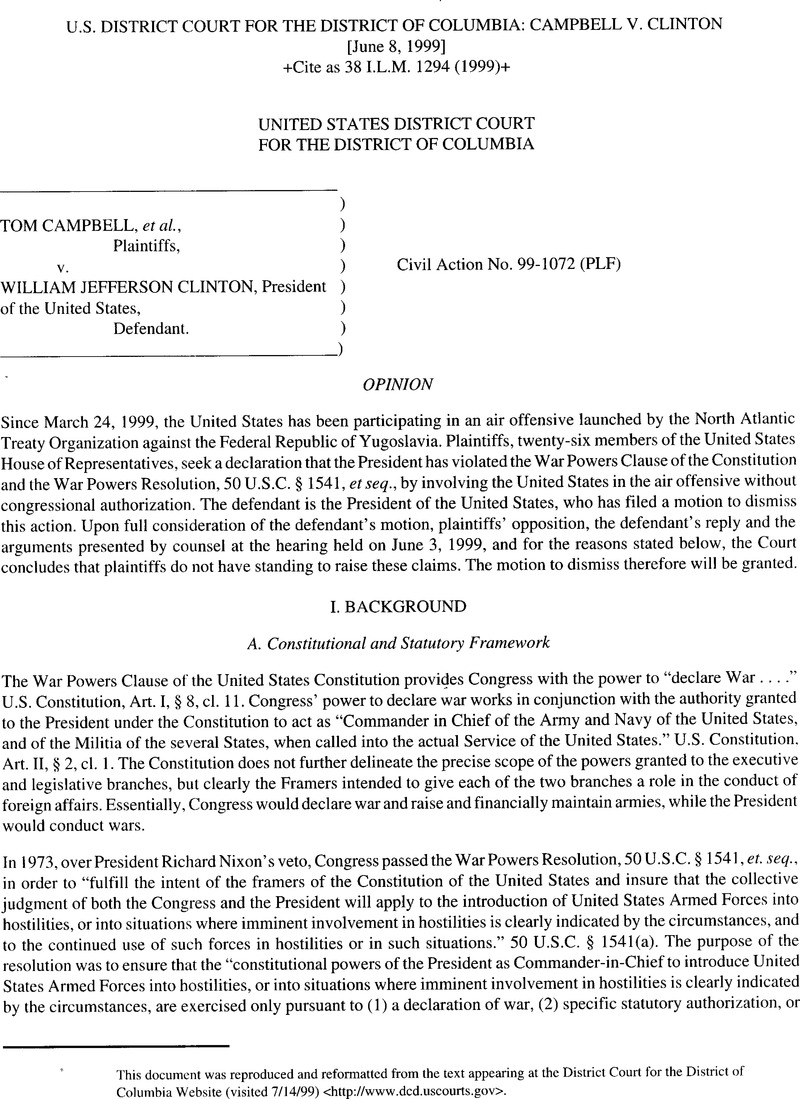No CrossRef data available.
Article contents
U.S.District Court for the District of Columbia: Campbell v.Clinton
Published online by Cambridge University Press: 27 February 2017
Abstract

- Type
- Judicial and Similar Proceedings
- Information
- Copyright
- Copyright © American Society of International Law 1999
References
* This document was reproduced and reformatted from the text appearing at the District Court for the District of Columbia Website (visited 7/14/99) <http://www.dcd.uscourts.gov.>.
1 Plaintiffs incorporated exhibits from their motion for summary judgment into their opposition to the President's motion to dismiss.
2 The Senate has taken no action on that bill.
3 On June 7, 1999, plaintiffs filed an Amendment to the Complaint to add five additional plaintiffs. The addition of these plaintiffs does not change the Court's analysis.
4 The Court does not understand whether or why plaintiffs believe the President did not comply with Section 1543(a) by virtue of the letters he sent to Speaker Hasten and Senator Thurmond on March 26, 1999. See supra at 6-7.
5 In addition to standing and ripeness, the President also has argued that this case raises a non-justiciable political question. To the extent that the President is arguing that every case brought by a legislator alleging a violation of the War Powers Clause raises a non-justiciable political question, he is wrong. See Baker v. Carr, 369 U.S. 186, 210-11 (1962) (“[I]t is error to suppose that every case or controversy which touches foreign relations lies beyond judicial cognizance….[The Court instead must conduct] a discriminating analysis of the particular question posed” in order to determine whether the issue is justiciable); Mitchell v. Laird, 488 F.2d at 614 (in some instances there may be “judicial competence to determine the allocation, between the executive and legislative branches, of the powers to wage war“). Because the Court concludes that plaintiffs lack standing, however, it need not reach the issue of whether this case is one in which the judicial branch has competence to adjudicate such questions.
6 It is clear that plaintiffs are suing in their official capacities as members of Congress and not in their individual capacities. Compare Amended Complaint at¶4 with Powell v. McCormack, 395 U.S. 486 (1969).
7 It is important to note that Coleman did not implicate separation of powers concerns to the extent that they are implicated in this case because the plaintiffs there were state legislators challenging the acts of a state executive. See Raines v. Byrd, 521 U.S. at 824 n.8, 832 n.3 (Souter, J., concurring). It is possible that the Coleman exception is further narrowed where, as here, plaintiffs are members of the federal legislature who are challenging the actions of the federal executive.
8 A finding that the legislative plaintiffs in this case lack standing under these circumstances does not preclude judicial resolution of a challenge to the President's actions. Counsel for the President appears to have acknowledged that an individual alleging personal injury from the President's alleged failure to comply with the War Powers Clause or the War Powers Resolution, as for instance a serviceperson who has been sent to carry our the air strikes against the Federal Republic of Yugoslavia, would have standing to raise these claims. See Def s Reply at 8. Compare Raines v. Byrd, 521 U.S. at 830 (members of Congress alleging institutional injury have no standing to challenge constitutionality of Line Item Veto Act) with Clinton v. New York, 118 S.Ct. 2091, 2099 (1998) (individuals alleging personal injury from President's exercise of power granted by Line Item Veto Act do have standing to challenge constitutionality of Act). The Court also notes that the political question doctrine does not apply to suits brought by individuals in their personal capacities. See Michel v. anderson, 14 F.3d 623, 628 (D.C. Cir. 1994).
9 While neither the defeat of the House concurrent resolution nor the passage of the Appropriations Act constitutes an “authorization” within the meaning of the War Powers Resolution, see 50 U.S.C. § 1547, congressional action on those measures is relevant to the legislative standing analysis.
10 Because plaintiffs’ alleged injury is caused in part by their failure to persuade their colleagues in the Congress to defeat the budget authorization bill and to vote for the resolution directing the President to withdraw troops from Yugoslavia, it also is not clear that plaintiffs can establish that their alleged injury is “fairly traceable” to the actions of the President rather than to the actions of their colleagues in the Congress. See Raines v. Byrd, 521 U.S. at 830 n.11.
11 The President has suggested that if Congress has available to it other remedies to check a President's alleged abuse of power such as impeaching him or withholding funds, a judicial remedy is precluded. That is incorrect. The mere availability of a legislative alternative is not sufficient to defeat standing; if it were, a legislator would never have standing since Congress always has the option of impeaching and removing the President. While the availability of such a remedy does not affect the standing analysis, the fact that Congress actually took contradictory steps certainly is relevant to a determination of standing under Raines and Coleman. If neither the budget authorization bill nor the measure directing the President to withdraw troops from Yugoslavia had been introduced or considered, the fact that Congress could have introduced such bills may not have been sufficient to defeat standing. But the House of Representatives did in fact consider and vote on both measures, and the congressional action on those two measures therefore cannot be ignored.




